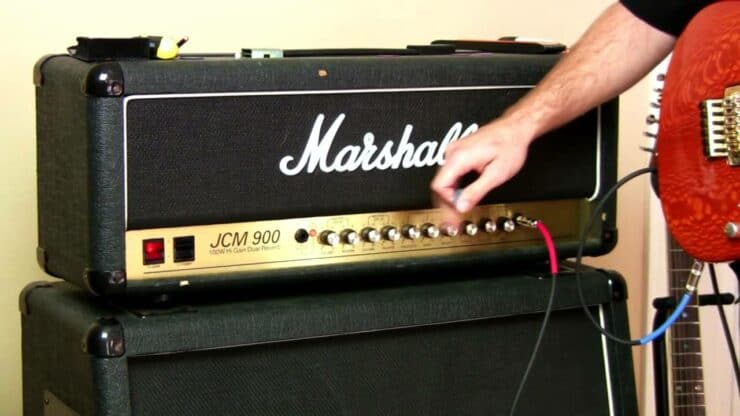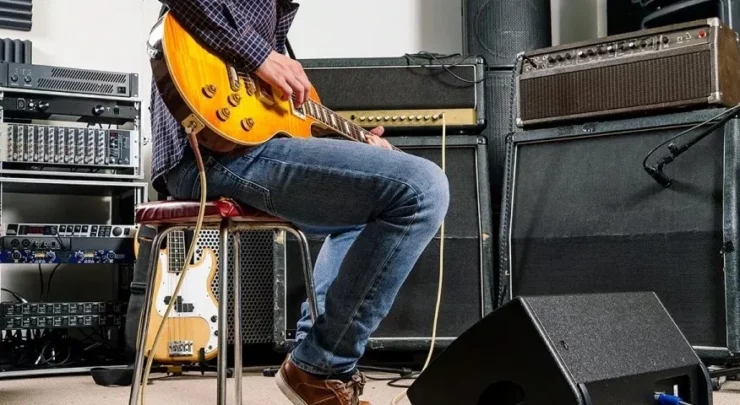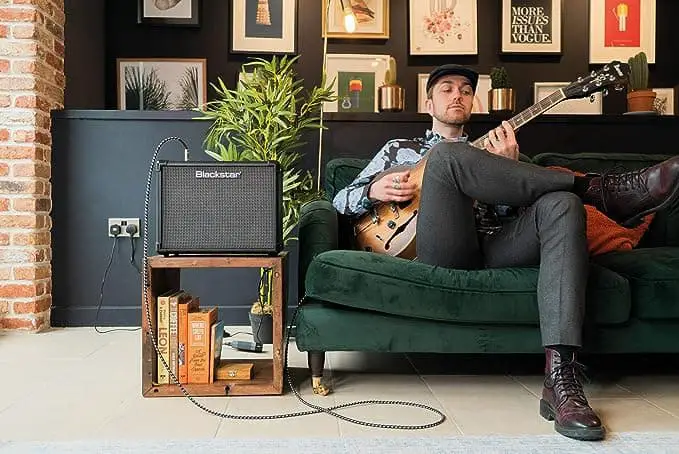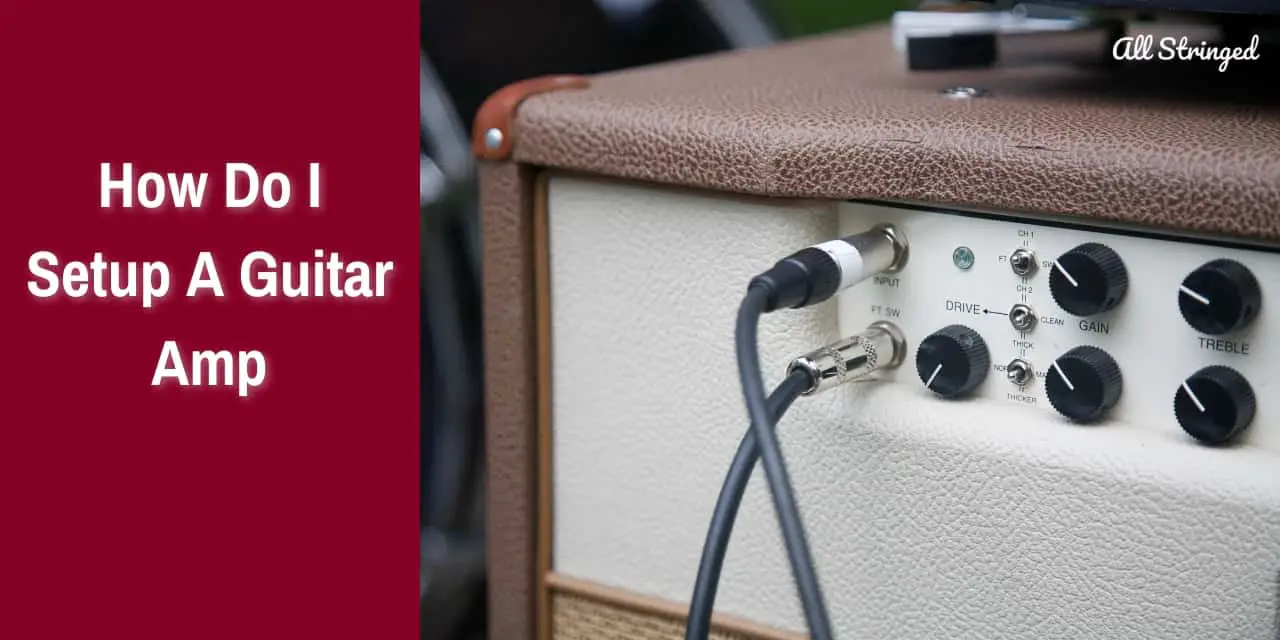As a guitar player, you may have asked yourself this question before. Setting up a guitar amp can seem complicated, but it doesn’t have to be. In this article, we’ll discuss the basics of setting up an amp and provide useful tips to make sure your amp is set up correctly. Keep reading to learn more and start playing your guitar with the best sound quality possible.
Preparation before setting up a guitar amp
Setting up a guitar amp properly is important for achieving the desired tone and getting the most out of your instrument. Whether you are a beginner guitarist or a seasoned veteran, taking the time to choose the right amp and gathering the necessary equipment will help you prepare for setting up your amp and getting the ideal playing experience. Here are the preparatory steps you’ll need to carry out before you can set up your guitar amp.
Choose the right amp
The first step involved before setting up your guitar amp is selecting the right amp that suits your playing style, musical genre, and performance requirements. First, you should determine the appropriate wattage for your needs. Lowe-wattage amps tend to be suitable for bedroom or studio practice whereas higher-wattage amps are better for live performances. Consider the venues you will be playing in to make sure your amp’s power can cut through the mix.
>>> Click here to read our review about the Top 15 Best Guitar Amps <<<
Decide whether you want to use a tube, solid-state, or digital amp. Tube amps are known for their warm, rich tones and dynamic response but they also require more maintenance and can be heavier. Solid-state amps offer reliability and affordability, with a cleaner and more consistent sound. Digital amps offer a wide range of tones and effects with convenient presets and recording capabilities.
Each amp has its own tonal characteristics. You should experiment with different amp models to find the one that perfectly complements your playing style and musical preferences. Pay close attention to the amp’s EQ controls as they play a massive role in shaping your tone.
Consider the additional features and effects offered by the amp. Some amps include built-in reverb, delay, or modulation effects while others might have a built-in tuner or multiple channels for switching between clean and overdriven tones. Choose an amp with features that align with your musical goals.

Gather the necessary equipment
Once you’re sure about the right type of amp, it’ll be time to gather the necessary equipment to set it up properly. Some of the essential items that you’ll need include guitar cables, a power supply, a speaker cabinet, pedals and effects, a speaker stand, and a tuner.
First, you need to invest in high-quality guitar cables for ensuring a clean and reliable signal transfer from your guitar to the amp. Opt for cables with sturdy connectors and good shielding to minimize noise and interference. Moreover, make sure you have a suitable power supply for your amp. Check the amp’s power requirements and use a stable power source to prevent voltage fluctuations or power surges that may damage your gear.
If you are using a separate speaker cabinet instead of a combo amp, make sure that it is compatible with your amp. Consider the cabinet’s size, speaker configuration, and power handling capabilities to match the amp’s output. If you’re using effects pedals or processors, gather the ones that you want to incorporate into your setup. Connect them between your guitar and the amp using the appropriate cables.
If you are performing on stage, a sturdy speaker stand or amp stand is important to elevate your amp for better projection and to prevent unwanted vibrations or rumble. Having a reliable tuner is important for keeping your guitar in tune. Consider using a dedicated tuner pedal or a clip-on tuner that attaches to the guitar headstock.
How do I setup a guitar amp?
Setting up a guitar amp properly is important for achieving the desired tone and getting the most out of your instrument. Once you have chosen the right amp and gathered the necessary equipment, it’ll be time to connect everything and fine-tune your sound. If you’re a beginner with the question how do I setup a guitar amp, then you will find your answer here. Here are the steps involved with setting up a guitar amp and getting the optimal sound.
Step 1: Connect the amp to the power source
Before you can start playing, you will have to connect your guitar amp to a stable power source. On the back or side of your amp, you will find the power input. Typically, you will find the power input on the back or side of your amp. It is usually a standard power socket or an IEC connector.
After that, you should check the power requirements. Refer to the amp’s manual or label to determine the needed voltage and amperage. Make sure that the power source matches the specifications to avoid any damage to your amp.
Make use of a reliable power cable. Plug one end of a suitable power cable into the power input of the amp and the other end into a grounded electrical outlet or a reliable power conditioner. Once everything has been connected securely, switch on the power using the amp’s power switch. Make sure that the power indicator light illuminates, indicating that the amp is receiving power.
Step 2: Connect the guitar to the amp
Once your amp is powered up, it’ll be time to connect your guitar and unleash the sound. First, you should locate the input jack on your amp, labeled as “input” or “instrument in”. It’ll usually be located on the front panel.
You should plug one end of a high-quality guitar cable into the output jack of the guitar. The output jack will typically be located on the guitar’s lower bout or edge. Plug the other end of the guitar cable into the input jack of your amp. Make sure that the connection is secure to avoid any signal loss or crackling noises.
Some amps also have an instrument switch or button that activates the input. You should make sure that it is engaged or switched on for proper signal flow.

Step 3: Adjust the tone controls
To achieve the desired sound, you will have to adjust the tone controls on your guitar amp. You will need to set the gain or volume, adjust the bass, mid, and treble, look after the presence or contour controls, and experiment with reverb or effects.
First, you will need to set the gain or volume control to an appropriate level. The gain control adjusts the input signal’s level while the volume control determines the output volume. Start with a moderate level to avoid distortion or excessive noise.
Most guitar amps feature tone controls, such as bass, treble, and mid knobs. These controls shape the frequency response of your sound. Experiment with different settings to find the desired balance and tonal characteristics.
Some amps also have additional tone-shaping controls, such as presence or contour knobs. These controls add sparkle or adjust the overall sonic shape. Fine-tune the controls to tailor your sound to your liking. If the amp has built-in reverb or effects, experiment with their settings to add some depth or ambiance to your sound. Adjust the reverb levels and experiment with different effects to enhance your playing experience.
How to set up the effects in a guitar preamp?
Once you have set up your guitar preamp, adding effects to the setup can take your sound to a whole new level. Whether you are a beginner or an experienced guitarist, connecting effects to your amp and adjusting their settings will be important for achieving the desired tones and unleashing your creativity. Here are the steps involved with setting up effects with your guitar amp.
Step 1: Connect effects pedals to the amp
To incorporate effects into your guitar amp setup, you will have to connect the effects pedals correctly. Decide on the order in which you wish to chain your effects pedals. The general rule is to place time-based effects (like delay or reverb) at the end of the signal chain, modulation effects (like chorus or phaser), in the middle, and gain-based effects (like overdrive or distortion) near the start. However, you should feel free to experiment and find the order that best suits your preferences.
Use high-quality instrument cables for connecting the output of one pedal to the input of the next. Start off by connecting the output of your guitar to the input of the first pedal in your chain. After that, connect the output of each pedal to the input of the following pedal until you reach the last effect in the chain.
Some guitar amps feature an effects loop that allows you to place certain effects pedals between the preamp and power amp stages. If your amp has an effects loop, connect the send jack from the effects loop to the input of the first pedal, and the output of the last pedal to the return jack of the effects loop.
Depending on your effects pedals, they might require power. Use a reliable power supply or individual power adapters for each pedal. Make sure that you provide the correct voltage and polarity as specified by the pedal’s manufacturers.
Step 2: Adjust the effects settings
Once you have connected the effects pedals, it’ll be time to fine-tune their settings to achieve the desired tones and textures. Some of the important considerations to remember include individual pedal controls, gain staging, tonal balance, and presets.
Each effects pedal will have its own set of controls. Familiarize yourself with the specific functions of each control, such as level, rate, depth, tone, or feedback. You should experiment with different settings to find the desired sound.
Pay close attention to the overall gain staging in your effects chain. Adjust the input and output levels of each pedal to make sure there is a balanced and consistent signal flow. This will help you maintain clarity and avoid excessive noise or signal degradation.
Consider the tonal characteristics of each effect and how they interact with your amp’s tone controls. For instance, if you have a bright-sounding pedal, you may have to adjust the treble control on your amp to balance the overall tone. Experiment with different combinations to find the best tonal balance.
If you have multi-effects units or digital pedals with preset capabilities, take advantage of the presets to save and recall your favorite settings. This allows for easy access to different sounds during performance or recording sessions.
Pay close attention to how your effects pedals respond to your playing dynamics. Some pedals might be more sensitive to picking strength or volume knob adjustments. Explore how different playing techniques and dynamics affect the behavior of your effects for expressive control.

How to test your guitar amp
Choosing the right guitar amp will be important for achieving the desired sound and enhancing your playing experience. While specifications and reviews will provide useful information, nothing compares to firsthand experience. Testing a guitar amp will allow you to listen to its unique characteristics, responsiveness, and tonal capabilities. Here are the different ways you can test a guitar amp.
Listening to sound samples
One way of assessing the capabilities of a guitar amp will be by listening to sound samples. Sound samples provide a convenient way to hear the amp’s tonal characteristics and how the amp responds to different playing styles and musical genres. You can take the help of online resources, YouTube, and more.
Many manufacturers and retailers provide sound samples on their websites or online platforms. These samples could include recordings of various guitarists playing through different amp settings. Look for samples that match your musical style and preferences.
YouTube will be another option. YouTube is a treasure trove of guitar amp demos and reviews. Numerous channels offer in-depth demonstrations, comparisons, and reviews of different amp models. You should look for reputable channels or specific guitarists whose playing style resonates with you and listen to their amp demos.
When listening to sound samples, make use of a high-quality pair of headphones or good speakers to make sure you get an accurate reproduction of the sound. Pay close attention to the nuances, dynamics, and tonal range of the amp. Take note of how the amp handles clean tones, overdrive, distortion, and any effects that might be included.
Make sure to compare different amps. Sound samples offer a great opportunity to compare various amp models. Listen to different sound samples from various amps to help you make a well-informed decision. Focus on the tonal qualities, dynamics, note articulation, and overall sonic character that align with your playing style.
Test the amp in person
While sound samples do offer a glimpse into the amp’s capabilities, nothing beats testing the amp in person. First, you need to find a local music store that carries the amp models you are interested in. Music stores typically have dedicated areas for testing amps, allowing you to connect your own guitar and try them out.
You should bring your own guitar when testing amps. This will ensure that you are evaluating the amp’s performance with an instrument you are familiar with. Your guitar’s pickups, tonewoods, and playing style contribute to the overall sound, so it is important to test the amp with your own setup.
Spend some time experimenting with the amp’s controls, including gain, EQ, volume, and any built-in effects. Explore the amp’s tonal range by trying various settings and playing techniques. Pay attention to the responsiveness, touch sensitivity, and versatility of the amp.
Test the amp with different musical genres to evaluate its versatility. Pay clean tones, crunchy rock riffs, bluesy licks, and high-gain metal passages to gauge how well the amp handles different styles and textures.
If you’re planning on using the guitar amp for live performances, consider the venue, size, and requirements. Test the amp’s volume capabilities to ensure it can adequately project your sound in different settings.
Tips to get the best sound out of your guitar amp
Getting the best sound from the guitar amp is the ultimate goal for any musician or guitarist. Whether you are a beginner or an experienced guitarist, there are several tips and techniques that can help you optimize your amp’s performance and achieve the desired sound. Here are some valuable tips to help you get the best sound out of your guitar amp.
#1. Know your guitar amp
Understanding your guitar amp is the first step toward getting the ideal sound. Take the time to read the instructions manual and familiarize yourself with the features, controls, and settings. Learn about the amp’s tonal characteristics, EQ options, built-in effects, and any unique features it might offer. This knowledge will help you make informed decisions when adjusting your amp for different musical contexts.
#2. Experiment with EQ settings
The EQ controls on your amp are powerful tools for shaping the tone. Experiment with the bass, mid, and treble controls to find the optimal balance for your playing style and musical genre. Adjusting these controls will greatly impact the overall character and clarity of the sound. Start with a neutral position and make gradual adjustments until you achieve the desired tonal balance.
#3. Mind the gain
Proper gain staging is important for achieving a balanced and harmonically rich sound. Set the gain levels on your amp appropriately for the style of music you are playing. Avoid excessive gain settings that result in muddy or indistinct tones. Experiment with different gain levels to find the sweet spot that retains clarity, dynamics, and note definition while providing the desired level of overdrive or distortion.
#4. Use your guitar’s controls
Do not overlook the controls on your guitar itself. The volume and tone knobs on your guitar can significantly affect your guitar amp’s response and tone. Explore the different settings and experiment with rolling back the volume knob for cleaner tones or dialing it up for more drive. Adjusting the tone knob can also shape the overall brightness or warmth of your sound. Use your guitar’s controls in conjunction with your amp as it can unlock a wide range of tonal possibilities.
#5. Consider the positioning and room acoustics
The placement of your amp and the acoustics of the room can impact your sound. Experiment with different amp placements to find the sweet spot that maximizes projection and resonance. Consider the room acoustics too. If the room is too reflective, it might result in excessive reverberation or unwanted resonance. Adding some room treatments like rugs, curtains, or diffusers can help tame any undesirable reflections and improve the overall sound quality.
#6. Experiment with pedals and effects
Effects pedals can enhance your guitar amp’s sound and provide additional sonic possibilities. Experiment with different combinations of pedals to explore new textures and tones. Use effects sparingly and thoughtfully, allowing them to complement and enhance your core tone instead of overpowering it. Pay close attention to the order in which you connect your pedals as this can greatly impact their interaction and the overall sound.
#7. Listen and tweak
Take the time to listen to your sound carefully while playing. Pay close attention to the nuances, dynamics, and subtleties of your playing. Tweak the settings on your amp as you’re playing to find the optimal balance and response. Make small tweaks and adjustments and listen to how each change affects the overall sound. Trust your ears and fine-tune the settings until you are satisfied with the tone.
FAQs
What are the basic steps for setting up a guitar amp?
The basic steps for setting up a guitar amp include connecting the guitar to the amp, setting the volume and tone controls, adjusting the gain and presence controls, and configuring effects. It’s important to follow the specific instructions for your amp to ensure proper setup.
What are the most important settings for a guitar amp?
The most important settings for a guitar amp include the volume and tone controls, gain and presence controls, and effects configuration. Adjusting these settings will allow you to customize the sound of your amp to best suit your playing style.
What should I do if I’m having trouble setting up my guitar amp?
If you are having trouble setting up your guitar amp, you can consult the manual that came with your amp or contact the manufacturer for further assistance. Additionally, you can use online resources and forums to get advice from other guitarists who may have experienced similar issues.



